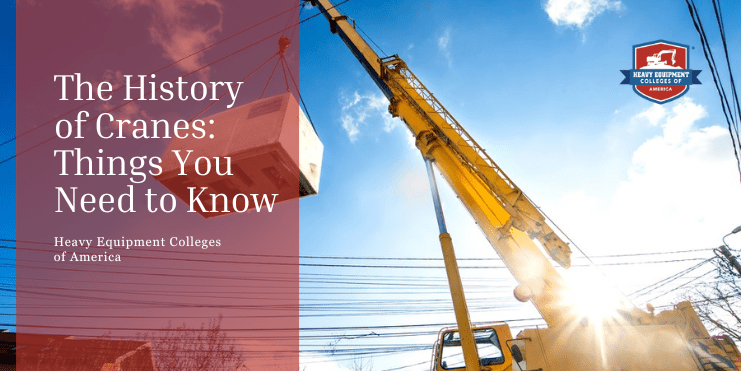If you live in Georgia, Oklahoma, California, or Washington and want to become a crane operator, find a comprehensive training program at Heavy Equipment Colleges of America (HEC). We offer training courses for tower cranes to hydraulic boom cranes and everything in between. Keep reading to learn about the history of cranes, various crane types, and crane safety.
Table of Contents
The History of Cranes
1. The Earliest Cranes
Starting as early as 1500 BC, the ancient Mesopotamians used pulley systems to lift and transport heavy loads. Along with irrigation tools called shadoofs, this equipment laid the groundwork for crane development. The machinery at this time was slow-moving and stationary, so movement during operation was extremely limited. Most cranes were either hand-powered or water-powered at this time.
2. The First Construction Cranes
During the 6th century BC, the Greeks developed the earliest form of what we know as cranes today. The Greeks used them to build monuments, transport mining materials, and construct buildings like cathedrals.
3. Cranes in Ancient Rome
The ancient Romans caught wind of what the Greeks were doing and improved their methods. They used more advanced technology and had more resources than other civilizations during that time. The Romans are known for developing the first treadwheel crane, which was used from 1225 until the 17th century.
Heavy Equipment Operator Guide
Want to learn How to Become a Heavy Equipment Operator?
Follow this Guide and Start your journey towards a rewarding career as a Heavy Equipment Operator today.
Start Here!4. Invention of the Hydraulic Crane
Hydraulic technology that was developed by Blaise Pascal in the 15th century became the foundation for modern hydraulics. Years later, in 1883, William Armstrong built the very first hydraulic crane.
5. Modern Cranes
Modern hydraulic cranes were originally inspired by Armstrong’s invention, and they utilize the same mechanical and hydraulic principles that Blaise Pascal developed in the 15th century. The main difference is that modern cranes are constructed with better materials and have higher lift capacities. As the use of iron increased, and industrialization spread during the Industrial Revolution, cranes started being made with iron rather than wood and other materials. The first cast iron crane was built in 1834.
Common Types of Cranes and Their Uses
When it comes to cranes, there are two main categories: mobile and static. Mobile cranes move from one location to another on either treads or wheels. Static cranes are secured to the ground and follow a fixed path. Below are three popular types of each crane category.
1. Mobile Cranes
- Swing Cab Crane
Unlike fixed cab cranes, swing cab cranes provide the operator with 360-degree visibility. All the operator has to do is swivel the cab in his or her desired direction. - Lattice Boom Crane
Lattice boom cranes feature a long arm that extends from the base. Unlike the lever on a hydraulic boom crane that slides in and out, the arm on a lattice boom crane slides moves up and down. - Hydraulic Boom Crane
Hydraulic boom cranes have an operator’s cab that contains levers. These levers slide the boom—or the arm—in and out through the hydraulic mechanism.

2. Static Cranes
- Tower Cranes
Tower cranes feature a tower and a rotating jib that the trolley and hoist move along. - Overhead Crane
Overhead cranes feature an overhead bridge that moves forward and backward on a runway while the hoist moves parallel along the beam itself. - Fixed Cab Crane
Fixed cab cranes feature a cab that resembles a typical truck cab. Since the cab remains stationary, the operator only has a clear view of what’s in front of or beside the crane.
The Importance of Crane Safety
Crane safety is essential to worker safety. That’s why OSHA (the Occupational Safety and Health Administration) requires routine safety inspections to ensure equipment complies with current government and company standards. These safety inspections check for things like:
- Excess component wear and tear
- Loose bolts
- Cracks
- Compromised electrical wires
This safety measure minimizes errors and accidents that can result not only in damaged equipment but also in worker injury or even death.
At HEC, we also require all students to wear proper personal protective equipment (PPE) when on the job. Essential safety gear includes:
- Safety glasses
- Safety vest
- Boots
- Hard hat
- Gloves (preferred but not required)
Get Crane Operator Training at HEC
Are you ready to pursue a career in the heavy equipment industry? Enroll in one of our accelerated programs to earn your mobile crane certification in as little as three weeks. Click the button below to start your heavy equipment training today.
Ready to Operate Heavy Equipment?
Get Certified with HEC Today!
Accelerated Programs | Multiple Locations | Job Placement Help
Open The Door To A New Career!
Start Enrollment ProcessFind The Right Location For You
